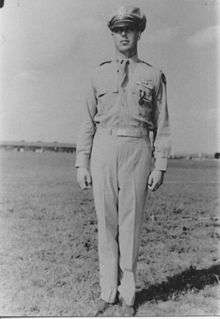Rex T. Barber
| Rex T. Barber | |
|---|---|
|
Barber after being awarded the Navy Cross | |
| Born |
May 6, 1917 Culver, Oregon |
| Died |
July 26, 2001 (aged 84) Terrebonne, Oregon |
| Place of burial |
Redmond Memorial Cemetery Redmond, Oregon |
| Allegiance |
|
| Service/branch | |
| Years of service | 1941-1961 |
| Rank |
|
| Battles/wars | World War II |
| Awards |
|
Colonel Rex T. Barber (May 6, 1917 – July 26, 2001) was a World War II fighter pilot from the United States. He is best known as a member of the top secret mission to intercept the aircraft carrying Japanese Admiral Isoroku Yamamoto in April 1943.[1][2]
Personal life
Born and raised in Culver, Oregon, Barber's parents were Charlotte F Barber and William C Barber.[3] He was a student at Linfield College and then Oregon State College in Corvallis; he majored in agricultural engineering from 1937 to 1940 before enlisting in the U.S. Army Air Corps in September 1940.[3]
Barber married Margaret I Trollope (February 11, 1918 – April 26, 2005[4]) at Tyndall Field on October 3, 1947.[5] They had two sons, Rex Barber Jr. and Richard Barber.[3]
Military service
Barber received his commission as a U.S. Army officer and his pilot's wings on October 31, 1941. He joined the 70th Pursuit Squadron, which arrived at Guadalcanal, Solomon Islands, in December 1942. Flying a Bell P-39 Airacobra, he scored his first victory by downing a Japanese bomber on the 28th. Upon transfer to the 339th Squadron, he began flying P-38 Lightnings and claimed two Zero fighters on April 7.
On April 18, Lieutenant Barber figured prominently in the Yamamoto interception, also known as Operation Vengeance. Intelligence sources had learned that Yamamoto would be flying in a "Betty" bomber on an inspection tour of Japanese bases in the northern Solomon Islands. Historian Donald P. Bourgeois credits Barber with the sole kill of Yamamoto's aircraft.[2] In 1991, Barber and Captain Thomas George Lanphier, Jr. were officially credited with half a kill each in Yamamoto's bomber after the Air Force reviewed the incident. Barber also shared a second Betty destroyed on the same mission. In 2003, Barber was credited by the Governor and Legislature of Oregon with the sole kill after an inspection analyzed the crash site and determined the path of the bullet impacts, thereby validating Barber's account and invalidating Lanphier's claim.[6] However, despite numerous appeals, the US Air Force refused to reverse its 1991 ruling giving each pilot half credit for the kill.[7]
After his tour of duty ended in June 1943, then-Captain Barber requested a return to combat. Late that year, he joined the 449th Fighter Squadron in China, still flying P-38s. He claimed three further Japanese planes probably destroyed and damaged, but he was shot down on his 139th mission, bailing out near Kiukiang on April 29. He was rescued by Chinese civilians, who treated his injuries and escorted him to safety five weeks later. At the end of the war, Barber attained the rank of major and commanded one of America's first jet squadrons. He retired as a colonel in 1961.
Decorations
Barber was awarded the Navy Cross, two Silver Stars, a Purple Heart, an Air Medal and numerous other awards over his military career, including the Veterans of Foreign Wars Gold Medal of Merit.
 Navy Cross
Navy Cross Silver Star with oak leaf cluster
Silver Star with oak leaf cluster Purple Heart
Purple Heart Air Medal
Air Medal
Return to civilian life
Upon his military discharge, Barber returned to Culver, Oregon, and resided there for the next forty years. He worked as an insurance agent and, at different times, served the city of Culver as mayor and judge.
He was a strong supporter of Little League Baseball, and often helped out local youth.[8][9] He was actively involved in service organizations until his death at Terrebonne, Oregon. His son, Rex Jr., is quoted as saying that his "afterburner just flamed out on him."
60th anniversary of the Yamamoto shootdown
On April 18, 2003, Governor Ted Kulongoski proclaimed the day "Rex T. Barber Day." The previous week, the Oregon State Legislature had declared that the new bridge on U.S. Highway 97 over the Crooked River was to be named the Rex T. Barber Veterans Memorial Bridge in his honor. (This bridge replaced the Crooked River High Bridge.) The new bridge, plaque and kiosk honoring Barber were dedicated on August 9, 2003 at Peter Skene Ogden State Scenic Viewpoint.
See also
References
- ↑ Goldstein, Richard (August 1, 2001). "Rex T. Barber, pilot who downed Yamamoto, dies at 84". New York Times. Retrieved February 11, 2014.
- 1 2 Bourgeois, Donald P. (April 18, 2013). "Historian says Oregonian Rex Barber shot down Yamamoto in World War II". Oregonian. Portland, Oregon. Retrieved February 11, 2014.
- 1 2 3 Matheny, Susan (August 7, 2001), "Flying ace Rex Barber dies", Madras Pioneer
- ↑ SS#: 547-22-6530. - U.S. Social Security Death Index. - U.S. Social Security Administration.
- ↑ Bailey, Joseph W., County Judge; and MacLeod, Roy M., Chaplain (October 3, 1947), Marriage Certificate # 9488, Office of the Clerk of Circuit Court, Bay County, Florida
- ↑ Notable Oregonians: Rex T. Barber—WWII Fighter Pilot and Ace from the Oregon Blue Book
- ↑ Sowell, John (November 10, 2014). "Did an Idahoan or an Oregon native shoot down Yamamoto?". Idaho Statesman.
- ↑
- ↑
- OSU's Famous Alumni
- Notable Oregonians: Rex T. Barber—WWII Fighter Pilot and Ace from the Oregon Blue Book
- Get Yamamoto Burke Davis 1969.
- Lighting Over Bougainville R. Cargill Hall 1991
- Lighting Strike Donald A. Davis 2005
External links
- Text of Oregon Joint Resolution 38 (2003) honoring Barber from the Oregon Legislative Assembly
- 456 FIS Rex T. Barber
- Rex T. Barber at Find a Grave
